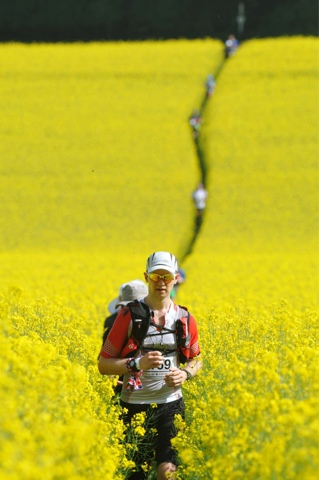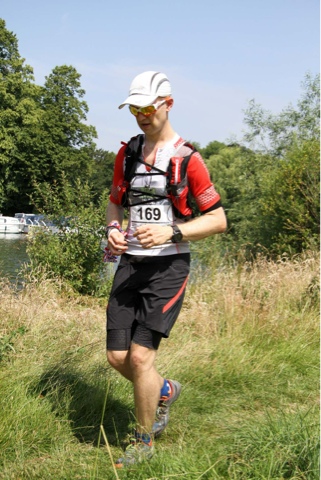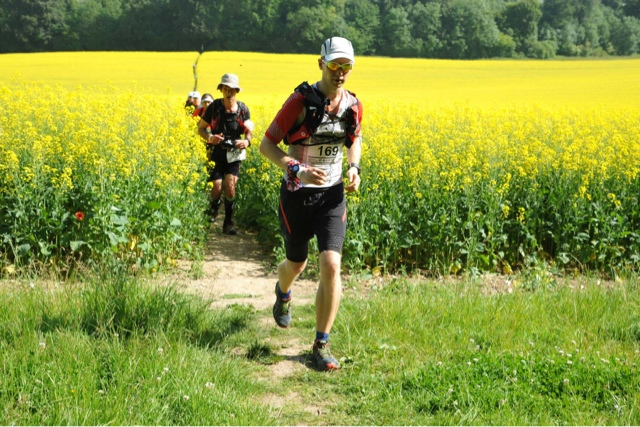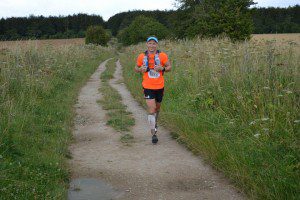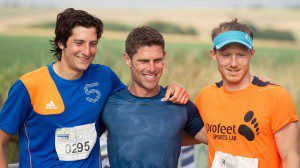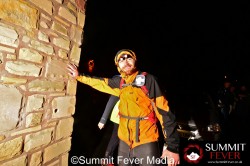
This little chunk of metal, an oval about four inches across, is a belt buckle that shows I finished a 100 mile race in under 24 hours. 23 hours, 15 minutes, 32nd place out of 150 starters. I’ve dreamed about winning this, or one like it, since I started running and discovered ultramarathons.
It’s the culmination of over 9 months of training. Of getting home from work, midweek, and eating dinner with Sarah and the kids before nipping out for a ‘quick’ run at midnight. Of getting up at 4:30 am at weekends and going for a longer run in the hills before getting back to breakfast while everyone else is waking up. Of planning, mapping and heading out on long adventurous running trips with friends. Of the low of the Punchbowl Marathon where lots of stuff went wrong, to the triumphant 10:08 50-mile PB at the SDW50, both with John Pickup. Of the disappointed elation of a 100-mile PB by four hours at the Thames Path 100, yet still coming in over 25 hours. Of the knuckle-gnawing disappointment of pulling out of the NDW100 in August at 91 miles, knowing that I’d injure myself further if I limped on. Of following a gruelling training plan. Of all those bloody roller sessions, strength sessions, speed sessions. All those expensive and exquisitely painful sports massages. Of absorbing inspiration from the amazing people in the Centurion Running and Bosh groups, like Jacqui Byrne and Luke Ashton and Tremayne Dill Cowdry and Ian Shelley and Shawn Timmons, and at times inspiring others to take up running. Of all the reliance on Sarah to keep things ticking over at home while I fussed over runs and rollers and kit and nutrition.
In August I attempted the NDW100 for the second year. First time was a success – finish at all costs was the brief I gave to my cowering mind, and it bullied my body into a finish in 29 hours 11 minutes. I didn’t run again for 4 months. This year the focus has been different; as races came and went I felt the constant need to return to them to do them better. My focus was becoming less about finishing long races and more about getting faster at them. My pullout this year was tactical, I knew with 11.5 miles to go that I could walk to the end, get a PB by a couple of hours, but what would that give me? A finisher’s shirt and a buckle, both same as last year, and perhaps risk further injuring my knee. It was a tough decision. I knew I had the Winter 100 coming up, and I felt it was better to pull out, recover, and come back stronger for the next race.
Saturday 18th October took a long time to come around.
In the weeks leading up to the race everything was perfect: I’d peaked at 84 miles a week training, tapered for 2 weeks, I’d done regular speed work and strength training. I’d had a couple of massages to make sure my legs and back were in decent shape, and I’d run at night and day in all sorts of weather and terrain. I felt unbreakable, until a couple of days before when I woke up feeling shivery and achey. After preparing for so long for a specific race the notion of not running it, or not running as well as hoped, because of a virus is acutely frustrating. So I regularly necked Lemsip and vitamins and slept as much as I could.
On Saturday morning I woke up and I could feel it. I felt overly hot and sweaty, and I had a sore throat that I knew wasn’t just a cold. I tried to remain confident, to fight the doubts and make myself believe it would be fine, but deep down I wasn’t confident at all. I didn’t tell anyone except Sarah and my coach because I hate making excuses for a potentially poor race; I don’t know why but I just prefer to keep it to myself. There was NO QUESTION of me DNSing this race, I just didn’t know what to expect from it with the illness. I overheard Ed Catmur, last year’s winner and record holder, say that he was feeling under the weather, and I figured that if he’s here like that then I’m in good company.
Sarah drove the kids and I over to the village hall at Goring and dropped me off before heading back home, as Billy had a school do to attend. It was raining as I pulled my bags out of the car and trudged into the hall for kit check.
I’d had plenty of time over the last few evenings to fanny about with kit. The Winter is a strange race in that you return to Goring at 25, 50 and 75 miles, and then again at the end – so you only need one drop bag and you can have it at any time. I’d assembled a couple of bags for 50 and 75 containing a dry base layer, hat, Buff, top and socks, plus a fresh pair of shoes for halfway in case I needed them. I also threw in a few extra pairs of socks, tops and another base layer, thinking they might come in handy.
Food-wise I packed 3 boxes of Morrison’s Bakewell Tarts – my favourite running food du jour – a pile of ham sandwiches that Sarah made for me, a dozen bananas, some flapjacks and a pile of Strawberry and Banana GUs. I packed a few carefully into my running vest – an Ultimate Direction SJ, which I really love. I weaned myself off a Salomon bladder earlier in the year after a split just before the TP100, and a quick experiment revealed that bottles worked for me and I haven’t looked back. I filled both bottles with water, and pinned my race number to my shorts. I think it was at that point that I realised how much Merino wool stuff I was wearing – my hat, Buff, base layer, gloves and pants were all made of the stuff. Basically I was to be a sheep for the day. I do love it though. Especially the pants.
After some unfortunate chafing on the NDW100 I needed to get some Glide ‘down there’. I went into the toilets and there was a big queue, so I just stood to one side and did the business, which must have looked a bit strange to the other chaps waiting for the loo. But I had to do it somewhere! After the race briefing and a final session of ‘dropping the kids off at the pool’ we all trooped down to the start line on the Thames Path. An inauspicious start position – no big inflatable start line, just a big group of runners standing about in a narrow car park. And then we were off, to some applause from onlookers. I love the beginnings of races. I love the end, too. Not sure about the middle bit mind.
The weather had been bad overnight, and although it wasn’t currently raining parts of the Thames Path were like a skating rink. Actually, probably more like a cross-country skiing course. My memory of the Thames Path from previous runs was of mostly tarmac and concrete, but it’s not – there are a lot of fields, earthy paths and rough areas. In places running was easier than walking, which was troubling because I didn’t intend to walk the whole thing. I ran 5 minutes and walked 1 minute right from the start. I was glad it was daylight because it would have been awfully hard in the dark, I thought – not thinking that the Thames Path on spur 4 might be equally slippery in the coming night. It was also very narrow in places, so I had to be flexible with my run/walk to avoid slowing other runners down behind me.
My nutrition was good right from the off, I found it quite easy to pack the calories in, took an S-Cap every hour, and I drank more water than I thought I needed, knowing that this race has an abundance of aid stations. The first, Wallingford at 6.5 miles, came and went – I made sure my number was recorded, popped in with my bottles already unscrewed for a refill, and popped straight back out again. It was like an F1 pit-stop, the most efficient I’ve ever been. I’ve done a couple of triathlons in my chequered ‘athletic’ past and I’ve never been all good at transitioning, so it felt great to do this first one so quickly. The weather was mild and the forecast rain didn’t seem to be anywhere near yet.
The next section was lovely, really easy to run and came with the added benefit of seeing other faster runners coming the other way. I passed Ed first (or, rather, he passed me) who seemed like an irresistible force travelling at my sprinting speed yet barely appearing to register an effort. He looked straight ahead, totally focused. At my speeds I don’t normally see quick runners in full flight so this was quite a special moment and spurred me on a little bit. A few minutes later I passed the guy in second place, who looked altogether more… normal, somehow. I remember thinking how could this guy be in second place, as he appeared to be running at a much slower pace than Ed. As he passed he looked me in the eye and said, with a Scottish accent, ‘well done mate’. I then passed a few other runners, and a couple of miles from Little Wittenham I passed Paul Ali, Tremayne Cowdry and Luke Ashton, and gave each of them a high-five – they were quite a way ahead of me already but that was OK. Today was about me and my plan, not racing anyone else – just focusing on getting under that 24 hour mark. The Little Wittenham aid station was a pagoda positioned behind a high wall up a little hill, almost as though it was hiding from the elements. One of the volunteers refilled my bottles, I grabbed a handful of peanuts and then ran back. Then it was my turn to pass runners on their way out, and I was determined to say well done to as many as I could to encourage them in the same way that the Scottish Guy had to me. I passed Ian Shelley and Shawn Timmons who both looked strong.
The return leg seemed much shorter than the way out, and it felt like no time before I was back at Wallingford and then back on the mud slide and into Goring for a pit stop at 25, about 4 hours 15 minutes in, which was on schedule. If I could get out quickly I’d have 6 hours to hit my target of halfway no later than 10 hours 30 minutes, which I knew I could easily do now as long as I didn’t hang about enjoying the warmth of Goring Village Hall. Immediately I walked in the hall and registered my number I was handed my drop bag by a volunteer. They were really on the ball with that all day – I didn’t need to ask for it once, it was just there waiting for me each time. I refilled my water, threw away my rubbish, and added enough food for 4-5 hours. It was a little warmer now and still no rain, and I regretted wearing SealSkinz waterproof socks during the first spur because really my feet were in little danger of getting wet. But I heard again that rain was coming soon so I made the snap decision to keep going with the SealSkinz and then think again at halfway. I headed out the door and onto the Ridgeway.
Like the Thames Path, this part of the Ridgeway is parallel with the Thames for about 5 miles, but on the opposite side of the river. It heads through fields and little villages like South Stoke and North Stoke, it has a great long section in the woods through the fabulously named Grim’s Ditch, and it has a challenging route through Nuffield golf course which I expected to be tricky in the dark. I was looking forward to this section, and at the end of it I’d be halfway done. I had a couple of cups of Coke at the North Stoke aid station. I really don’t like Coke except for when I’m running, where it tastes like the nectar of the gods and it’s a handy few calories to throw down. I tried to waste no time and dashed out again. About a mile further on I started to feel nauseous, so I slowed down a little bit, but pretty soon I had to be sick. With 70 miles to go I assumed my system wasn’t taking food in, and it was related to the virus, so I was worried. I walked for a couple of miles, regularly drinking water, and then had another salt cap and a bit of flapjack. It took a little while but eventually I started to feel a bit better, and began running a little again.
The Ridgeway towards Swyncombe is lovely, and it was nowhere near dark so it was a great, free run. On my recce I’d made a navigational error and missed a turn, adding on about a mile and a half – but none of that today. The route was well marked and I’d either run or recced the whole route before, but I was thankful on two occasions that other runners spotted a turning and a bit of tape that I may have missed had they not been there. This is the first long race where I didn’t get lost at least once. During my recce a few weeks earlier I remember an area with a couple of big fields which had just been ploughed. One was the sort of vast open space that gives you the feeling of vertigo looking across it, and I think it had been ploughed that morning because there were no tracks across it at all. I looked for signs of the Ridgeway continuing across it, spotted a couple of white posts, took a guess at the most likely one and ran across to it. This time, on race day, there was no such problem because both these fields had sprouted grass and the footpath was clear to see.
When I got to the top of Coneygear Wood a runner coming the other way told me that it wasn’t too far to the aid station. I’m not sure what I think about that sort of statement generally, because ‘not too far’ is relative – but I’ve learned to take it with a pinch of salt and extract the encouragement element while largely ignoring the distance information element. At Swyncombe I refilled, waved bye to the marshals and got on with the run. On the way back it was getting towards dusk and the wooded areas started becoming quite dark. It was only about 6 o’clock at this point though, and I’d planned on switching on my headtorch maybe an hour after this, so I ploughed on. It felt great to run in the woods on mulchy terrain, and I felt quick and spry. There was the odd tree root and other obstacles, plus a few direction changes, but they were easily negotiated even in near-dark and it was a wonderful part of my race. I saw a light in the distance and approached a runner wearing his head torch, heading in the same direction as me. As I passed him he jumped a little, which I guess is normal in a dark wood when approached by someone *not* wearing a head torch. I apologised and ran past him. A few minutes afterwards I couldn’t see the way, and relied on him catching me up to spot a signpost and a change of direction, and I realised that was perhaps a sign that I should be wearing my own torch and got it out. After a head torch disaster in the NDW100 this August I’d invested in a new Nao, and I do like it a lot – even on the lowest power it’s quite bright and apparently lasts for 12 hours. As it was heading towards 7pm now I was confident that it would survive the night and I wouldn’t have to mess about with any of the spare batteries I was carrying.
I continued to feel good running this section, and overtook a few more people along the way, quickly passing through Nuffield and North and South Stokes and texting Sarah and my brother Steve before heading back to Goring. A quick word on Nuffield: from one of my recces I was pointed to Nuffield Church for refreshments. There’s always fresh water, squash and a kettle with tea and coffee, and sometimes cake in the fridge, plus a little box for donations. It’s a lovely little church and I like that they have supplies for runners and walkers in case they’re passing, so if you’re in the area and need anything, just pop in.
Steve, Sarah and the kids were meeting me at halfway and Steve was to pace me. We’ve not run with each other much before, but he’s recently got into ultra-distance running and completed Race To The Stones in May with a decent time. Another friend of mine, Alick, was to pace me from 75 through to the finish, but he had to pull out due to ill-health. Steve’s response to that was “oh, I’ll just run the whole way with you.” What a trooper!
A few miles from halfway I texted Sarah and Steve and told them I was heading in, and asked if they would both be there. Because we’ve got young kids and they were staying in a local hotel I wasn’t sure if they’d still be up, but I got a text saying they were all there. Brilliant, that gave me a little boost. When I got there I headed through to register my number, picked up my drop bag (which was again handed to me automagically) and headed on through for hugs. Steve was about ready to go, so I started getting changed straight away. I swapped to a dry top and base layer, changed to Twin Skin socks and swapped shoes. These were a near-identical pair of Trailroc 255s, but a little newer so the grip would be better if the rain was finally to appear during the night. I’m glad I took lots of kit. The humidity meant everything got very sweaty despite the cold, and the facility to swap to whatever I liked was a big plus.
I said hi to Jacqui Byrne, a fellow Bosh runner and Goring volunteer for the day, and she got me some soup and bread which went down a treat. I had both bottles filled, one with half Coke half water, which is a new combination for me but I just felt like it was the right thing to do. I had this combo for the rest of the race, nice easy calories and I think it helped. I was dawdling though, I’d been about 20-25 minutes in there which I was a bit annoyed with myself about. It got to the stage where Jacqui was lurking and cajoling me to get out of the door. I kissed Sarah and the kids goodbye and Steve and I headed out.
I really enjoyed running from Goring 50 with Steve. We chatted about all sorts, and the miles ticked away. We ran the flats and downs, but I mostly only wanted to walk even the slightest uphills. It felt OK to do that, knowing that on the way back these would be runnable – and they were. That stretch of the Ridgeway, once it pulls away from the Thames, is extremely open and desolate, and it became quite cold, but it never seemed quite as inhospitable as I remember from my daytime recce. We kept moving well and Steve did a fantastic job of lighting the way – we both had head torches, and he had a bright hand torch as well which he shone across the path. That was particularly useful because my new Nao took this opportunity to flash and tell me the battery was expiring. It went to low-power mode, which I’m sure is still bright but it was terribly dim compared with how it had been. 6 hours from a battery that’s meant to last 12 hours; hmm, I need to investigate that. Then there was the aid station in the distance. We wondered what it could be – in reality it was a pagoda with some disco lights and music playing quite loudly, but from a couple of miles away it looked like an alien spacecraft. Wonderful to see that in (almost literally) the middle of nowhere. It had a real party atmosphere with music playing and some of the marshals were dancing; what a total contrast to the surroundings. I asked a marshal to refill my bottles while I sat down and replaced the rechargeable battery with a couple of Duracells for the return leg. This was fiddly in the dark but the marshals helped by keeping me well-lit. Steve changed his head torch batteries as well, and then we started running back, again trying to give some encouragement to the runners coming the other way. Even with new batteries the Nao went immediately into low power mode, so again I was really happy that Steve was around not only for company but with his extra lighting.
At this point I started having occasional feelings of despair about the 24 hour finish. Every so often I would calculate the number of hours remaining and quickly work out what I needed to do, and it wasn’t all good. I got to 50 miles in about 10 hours 15 minutes (8:15pm real time), and it seemed to take an age to reach 62.5 with all the uphill gradients and the walking. On the way back down I set a target of *leaving* Goring at 75 miles at 3am, giving me 7 hours to finish the last 25 miles. To leave Goring at 3am I would need to get there at 2:45am, and that meant we need to do the 12.5 miles back in about 2.5 hours – with low-power torches.
With the slight downhill gradients I felt like I was gliding along, but I fear Steve didn’t fare so well – his ankle was becoming more and more painful and a few miles from the end I could hear he was limping. Still, we were moving at a decent pace. We talked about whether he should stop at 75 or continue; and we decided he should stop. It would have been lovely for me to have his company for another few hours, running through dawn and on to the finish, but by the time we got to 75 at about 2:50am I felt quite fresh and I knew I could make it to the end on my own. I also thought that the Thames Path trail might be quite slippery and Steve might really hurt his ankle.
Making the 75 mile mark bang on time gave me a lot of confidence. I met up with Jacqui again who got me some more soup and bread, and a cup of tea. I shouted to James Elson that my 24 hours could be on, and he told me that it most definitely was on, that I should relax and go for it, not look at my watch, and I should be able to do it a lot under 7 hours. I saw Scottish Guy, Marco Consani, relaxing having already won the race with a course record of 15:03. That was humbling. I went over to him and asked if I could soak up some of his aura. I probably looked like a bloody lunatic, but I think it worked.
After leaving Steve and Goring, for the final time, just after 3am, I went out on the final spur. I really didn’t feel like running at all at that stage, and I’d assumed it would be flat. In reality it was undulating with a few short sharp climbs and downhills. My quads were letting me know they were there, and although I walked most of that 12.5 mile section I strode it out, doing 13.5 – 14 min/miles. Still, that feeling of despair appeared more than once, as I could feel my 24 hour finish slipping away. The first aid station was 4 miles in, and the next section – 8.5 miles into Reading – was horrible. There were 2 or 3 occasions when I thought I’d reached the aid station and I hadn’t. The first was a well-lit car park, the second was an empty field. With hindsight I asked too many runners coming the other way how long to the aid station. I got wildly different responses, which comes from asking people who’ve run over 87.5 miles about details of space and time. It felt never-ending, and this was my lowest point mentally. Finally I got to the aid station, and it was only then that I knew, reasonably concrete-ly, what I needed to do. I had about 3.5 hours to do 12.5 miles. I’d been running for over 20 hours at this stage and mental maths wasn’t a strong point, but I figured that meant below 4 mph, so should be possible even by walking it – but I wanted to be sure and as it was raining quite heavily at that point I knew that towards the end the ground would be a sea of mud. Somehow the knowledge of the distance galvanised me mentally. I ate a lot at the Reading aid station, asked for my Coke/water mix to be a little stronger, and just decided I was going to go for it. My quads were hurting and my toes felt hot, but otherwise I felt OK – and just putting one foot in front of the other with short steps came quite easy. So I started running. I don’t know where the energy to do that came from.
At the last aid station before the finish there was a little road leading up to it. Runners heading to Reading turned right, while people heading for the finish turned left. I felt physically sick imagining that I might have to turn right there. Yet still there were many runners coming towards me on that 4-mile stretch back to Goring. At no point in my races to date have I seen such humility, grace and raw drive that I saw in the eyes of those people. One held a large gate open for me and waved me through, and wished me good luck getting my sub-24. She had 20 miles yet to run. And she’s not alone. Shawn Timmons wished me all the best achieving my dream when he had a similar distance yet to cover. That really spurred me on and I had no trouble running then. Lots of runners clapped as I ran towards that finish, even though they had a long way to go. I felt more emotional than I ever have while running.
Towards the end a runner, not on the race, told me that I was the first person he’d seen running, everyone in front of me was walking. I thought for a brief moment of trying to catch them, but dismissed it quickly. I texted Sarah and told her I’d be there well within 24 hours, and it might even by 9:15 am.
Finally, having passed a sign for Goring Bowls Club, I asked a chap with his dog if this really was Goring, and was the village hall close by. It was – and he pointed out a chap waving to me a few hundred yards away, pointing up a slope. As I turned the corner I realised that was the final slope, and I was still running strongly at that point. I could see Sarah at the top, shouting to everyone that there’s a runner coming. I think Stuart the photographer had gone away for a minute and she was desperate that everyone should be there to see me and capture the moment. I felt an overwhelming urge to take my jacket and race vest off and fling them in the air while running on, and give her a big hug in some fantastic Hollywood-like scene. I don’t think it quite worked like that, but I’ll never forget her face, so much emotion, and that hug will stay with me for a while too.
This was the best races I’ve ever run. I did exactly what I needed to, and the result has given me huge confidence for progressing in 2015. The organisation was excellent as always, and the out-and-back format meant a great deal of contact with other runners which added a special element. From the encouragement and high-fives given by the leading runners while I was heading out, to the encouragement and high-fives that I could give to other runners on the way back, it was a highly unusual race and a tremendously uplifting experience. I will definitely do it again next year, especially now I know the lie of the land.
I became obsessed with this little piece of metal, or one like it, and now it’s mine. It’s been quite a journey getting here. Unlike my first 100-mile race last August, the NDW100, after which I didn’t run another step for 4 months, this time, a day later, I’m itching to get out again. I want to go faster. I want to run longer. I want to explore new places. I want to see what my body and mind can do.
There are lots of people to thank: the people of Bosh and Centurion running groups; the incredible volunteers who gave up their time to keep us healthy, happy and running; the other runners for a great spirit and camaraderie; Nici and James for organising the event and the latter for coaching me into shape; Stuart March for high fives and encouragement, and great photographs; Jacqui for hugs and help; Steve, for joining me for 25 miles on Saturday night in the pitch black and the rain, and for literally holding the torch when the going got bleak; Billy and Daisy for the little pictures they’d drawn for me. And most importantly of all, Sarah, for her unending support, enthusiasm, love and patience.








